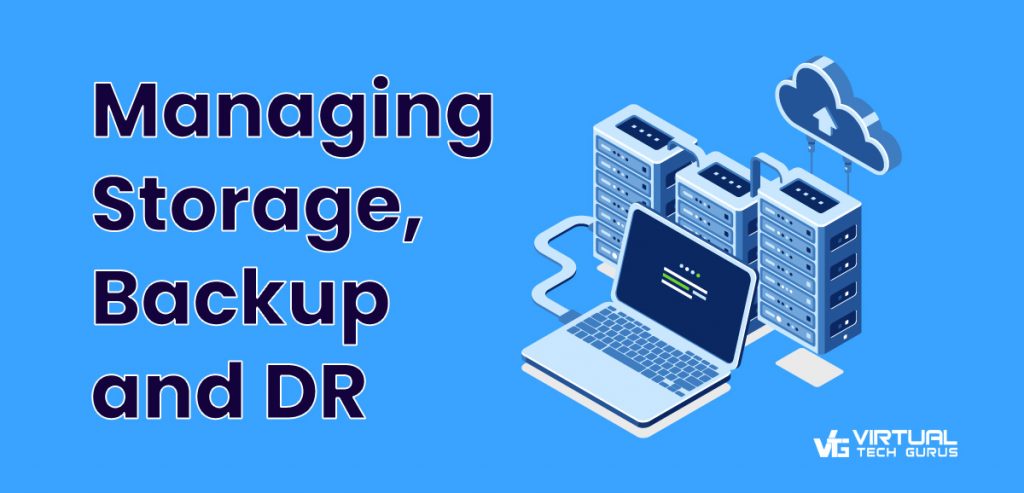
Managing Storage, Backup and DR
Storage
As big data analytics become increasingly crucial for businesses, managing an avalanche of structured, semi-structured and unstructured data in databases has become more of a challenge. According to Oracle, by 2020 most enterprises expect 50 times data growth. Hence companies are looking for options when it comes to storing data safely.
Depending on the type of business, their client base, the workload requirements etc.; the storage methods of an organization may vary. Enterprises may look to cloud storage (enhances collaboration, file sharing and storage expansion according to exact company requirements), network connected storage like NAS or SAN (if data security is paramount) or local storage (if it is a small business or has a low budget).
Whatever the means of storage, taking precautionary measures is something that all businesses should do to ensure that their stored data remains safe.
Having a data backup is the best practice in the event of data loss due to unexpected server failures, hacking or breaches, or in the case of disasters like fire or flood- so that the data should be easily recovered with minimal downtime.
Backup and Disaster Recovery
Disaster Recovery (DR) is the process, policies and procedures related to preparing for recovery or continuation of the technology infrastructure which are vital to an organization after a disaster. Data backup, on the other hand, is simply an on-going scheduled process (automation) of backing up your data.
The first step of DR planning is to ensure the survival of your data; and the basis for most data protection strategies is a backup, a recurring copy of data stored on another on-site system.
Key points to consider:
- What type of backup do you need and how much storage is required?
- How many users and devices do you need to maintain back up and support?
- How quickly do you need to recover the data?
Tape Backup: Some say the Tape is fading away. But, if you’ve already made an investment a few years back in tape technology, and if it is still working for you, it is still very relevant.
Traditional DR model was based on tape backup, with secondary backup tapes stored offsite. But this model can incur significant downtime, as tapes must be retrieved before data and applications can be restored. So when it comes to a failover-type scenario where you can’t have any downtime or you need things restored instantly, you need to start looking at data replication and clustering. In such cases, tapes are not the best answer to supporting that type of technology.
Cloud Backup: So what happens when there is a site-wide outage or disaster event such as a fire or flood which could jeopardize all the onsite equipment and your IT environment? In that case, having a copy of data offsite or on cloud can save you from permanent data loss.
With cloud based backup, data is taken from the local backup or imaging software and sent to an offsite data center that meets industry compliance standards in terms of both security and privacy. A reliable internet connection is essential for cloud backup. One of the reasons that companies outsource their data backups to cloud data backup service providers is to offload the burden of monitoring, maintaining and supporting the infrastructure.
Cloud DR models are mainly based on an organization’s specific RTO (Recovery Time Objective)/RPO (Recovery Point Objective) requirements and can be:
- Data only
- Application based
- VM image – VM image backup can also be used as a method of protecting physical (bare metal) application deployments through P2V replication.
With a cloud-based disaster recovery service, businesses can provide continuity for their operational service regardless of where they are delivered from,perform tactical failover to secondary services in the event of a hardware or software failure in some (or all) of their IT systems and migrate workloads to cope with unplanned demand or growth.(You can also read our article on ‘DR with Hybrid cloud’)
And there is no doubt, whatever your investment is in a DR plan, it’s going to be a lot cheaper than the cost to recover after a disaster without having one.
With the market now moving towards the managed services model, especially when it comes to Storage and Backup solutions, most SMBs can benefit significantly from having an MSP to work in tandem with your in-house IT staff to provide a Capacity Planning for your storage and backup needs and Business Continuity Planning to ensure smooth recovery during a threat or disaster.
Check out our white papers and articles on our website for more information.
